Sharks are nearly impossible to avoid if you’re swimming off the coast of California. There are hundreds of shark species throughout the world. Although sharks have a terrifying reputation, they rarely attack when provoked. For instance, in 2022, there were 57 unprovoked shark attacks in the world and only four shark attacks in California. This number is so low, especially if you consider how many people visit the beach each year! Although it’s unlikely you’ll run into all of them on your next visit, here we have a list of the 11 sharks found in San Diego and La Jolla.
Are Sharks Common in San Diego and La Jolla?
Sharks are very common in San Diego. On some beaches, you can even find shark warnings, however, it’s generally safe to swim in the water. Sharks rarely attack humans. Most attacks are actually because they’ve been provoked or out of confusion. Sometimes, loud splashes get mistaken for fish or seals. Sharks may also get close to surfers trying to identify what they are as sharks have poor eyesight.
Although sharks live in both San Diego and La Jolla, there’s no guarantee you’ll see one on your next visit. In La Jolla though, you can swim with leopard sharks, which are harmless. You can book a snorkeling excursion or boat tour to get close to them. Although considered harmless, it’s best not to disturb them. They are still wild animals.

Some shark species are common in La Jolla.
©amadeustx/Shutterstock.com
The 11 Sharks Found in San Diego and La Jolla
There are likely a lot more than 11 sharks that pass through San Diego or La Jolla, however, they are quick visitors. Instead, here we have a list of 11 sharks found in San Diego and La Jolla, although some are more common than others.
Leopard Sharks
The first shark on our list is the most common in the area, the leopard shark. Leopard sharks are harmless sharks with a wide range. They are found along the Pacific coast of North America. These sharks mainly live near the coast and sometimes are spotted in large schools, especially in bays. Leopard sharks are slender with easy-to-identify black spotting on their bodies, similar to leopard print. These fast predators aren’t picky eaters. They eat just about anything and are often found hunting in one area for fish, crustaceans, and clams. Leopard sharks often interact with humans. They are one of the most common sharks seen by divers. Interestingly, there has only ever been one violent interaction between a leopard shark and a human, and the human went home safe afterward, but with a bloody nose.
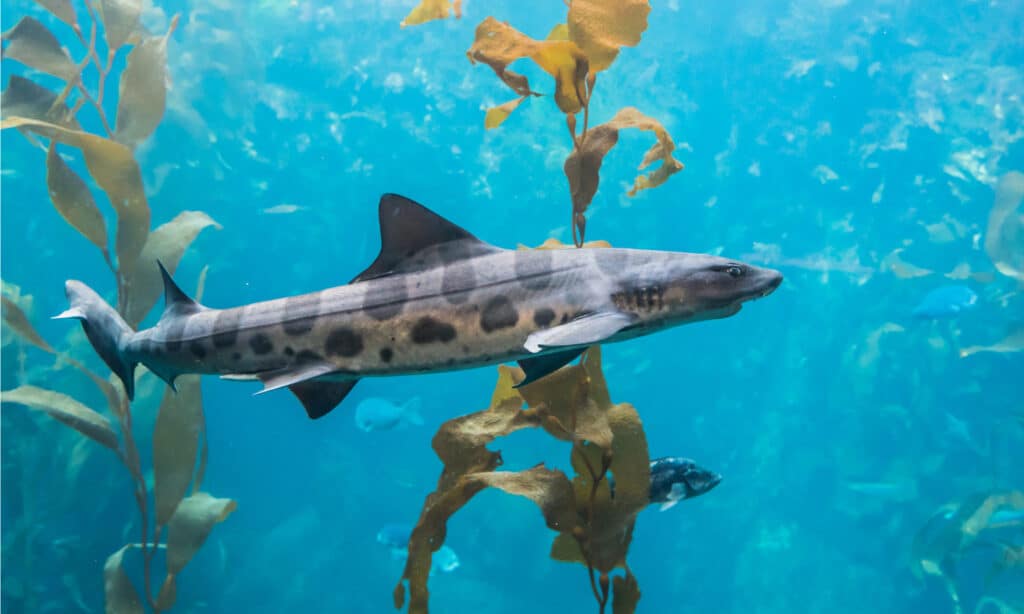
©David A Litman/Shutterstock.com
Broadnose Sevengill Sharks
Next on our list is the broadnose sevengill shark, also common off the coast of San Diego and La Jolla. You can dive with these unique and calm sharks in La Jolla. The best time to see the broadnose seven gillshark in La Jolla is during spring, however, they live near the coast all year round.
Broadnose sevengill sharks are coastal. They typically spend most of their time in depths as low as 50 feet. These sharks are members of the Hexanchidae family. They are sadly listed as Vulnerable on the IUCN Red List. Male broadnose sevengill sharks are about 4.9 feet long, while females average about 7.2 feet long. They are mottled grey, with large mouths and small eyes.
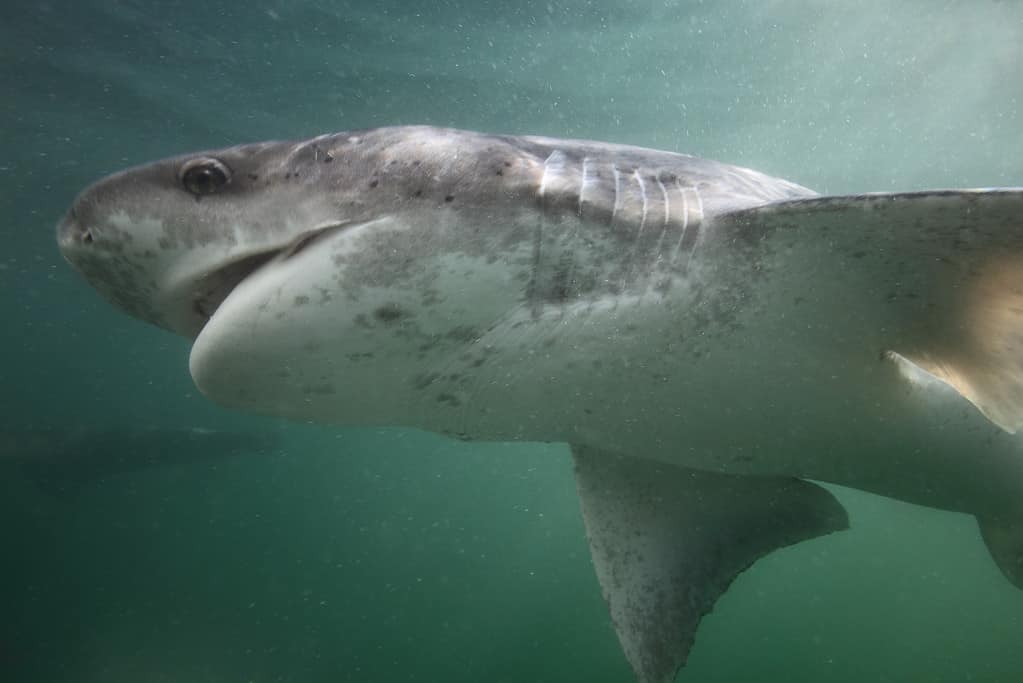
Broadnose sevengill sharks are large sharks about 4.9 feet long. Females are larger at about 7.2 feet long.
©iStock.com/Alessandro De Maddalena
Horn Sharks
Another common shark found in San Diego and La Jolla is the horn shark. This shark is the most unique species on this list. It has a short, wide head with a blunt snout. This shark species is most notable for the prominent supraorbital ridges over the eyes. Horn sharks are members of the Heterodontidae family. They live in the coastal waters off the western coast of North America. These unique fish have small, curved mouths. They are also brown-grey and spotted. Horn sharks are one of the smaller shark species. They typically reach about 3.3 feet but can grow larger. In California, you can find horn sharks in shallow waters less than 40 feet deep.

Horn sharks have a unique appearance. They also only reach about 3.3 feet long.
©Greg Amptman/Shutterstock.com
Tope Sharks
You can also find tope sharks off the coast of San Diego and La Jolla, although they aren’t as common as leopard sharks. Tope sharks go by many names. They are also referred to as soupfin sharks, school sharks, and snapper sharks. Tope sharks have a wide range. They are found worldwide, however, they are listed as Critically Endangered on the IUCN Red List. Sadly, these long, but docile sharks, are frequently hunted. They are threatened by overharvesting. This fish is targeted for its liver oil, flesh, and fins. It’s eaten in many cultures. For example, in Andalusian cuisine, tope shark meat is cooked. This shark is also served in Greece, Mexico, and New Zealand.
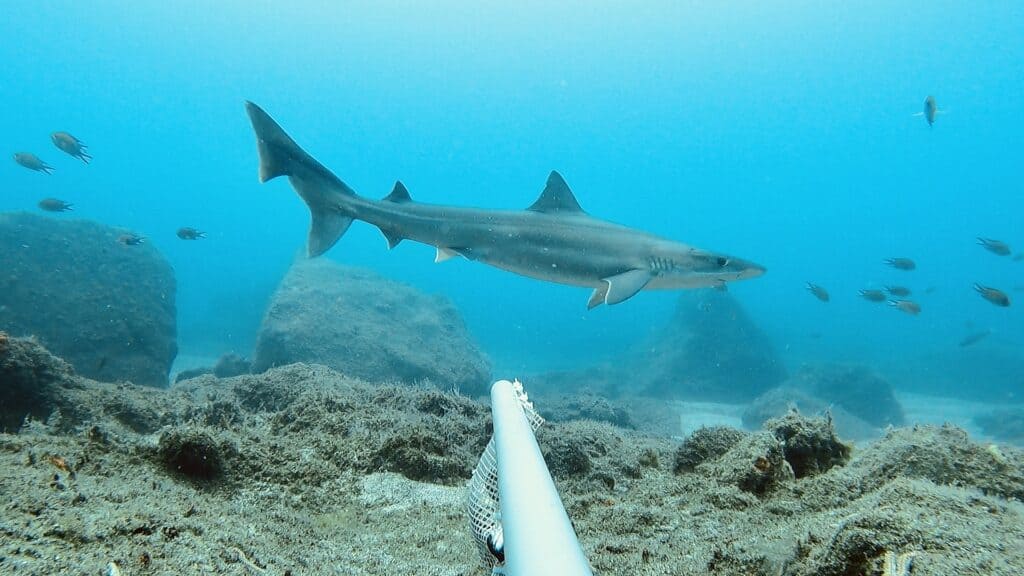
Tope sharks are listed as critically endangered on the IUCN Red List.
©AshlieJMcivor / cc by-sa 4.0 – License
Swell Sharks
Off the coast of San Diego and La Jolla, you may also encounter swell sharks. These sharks are catsharks in the family Scyliorhinidae. They are native to the tropical and subtropical eastern Pacific Ocean. Swell sharks get their name for their interesting ability to quickly expand when threatened. Swell sharks can ‘swell up’ by swallowing water as a form of defense. These unique animals are very common. They are listed as Least Concern on the IUCN Red List. Swell sharks are about 32.3 to 34.6 inches long. The largest swell shark ever recorded was 43 inches long. Swell sharks are threatened as they accidentally get caught in nets. However, swell sharks aren’t overly hunted by humans as their meat is considered poor quality.
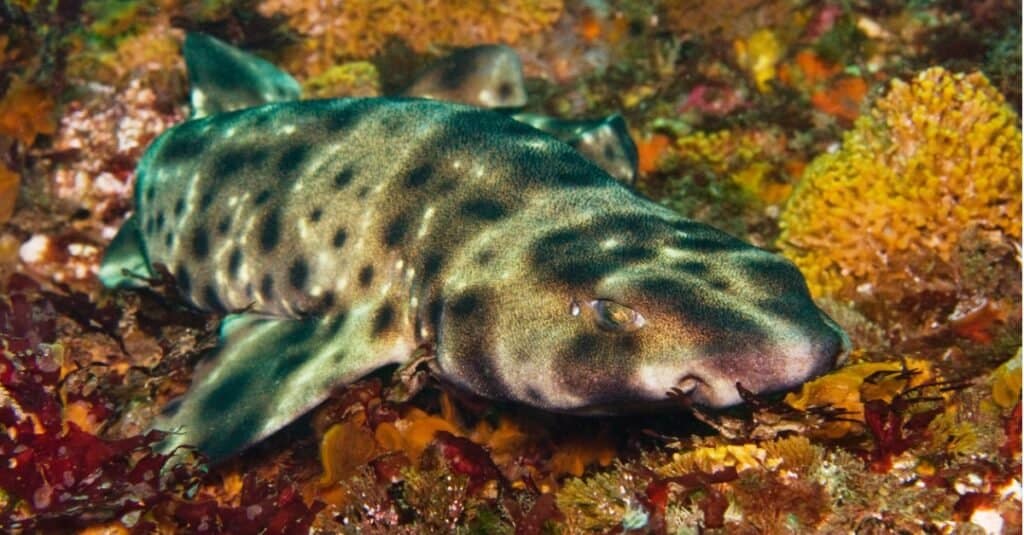
Swell sharks are another shark found in San Diego and La Jolla.
©iStock.com/Natalie Ruffing
Gray Smooth-hound Sharks
The gray smooth-hound shark is a member of the family Triakidae. They are found throughout California in depths up to 150 feet. Gray smooth-hound sharks are small. They reach about 46 inches long. These small sharks are sometimes found near the Crystal Pier in San Diego. They’ve also been found schooling with leopard sharks. You may see them when diving in California. Gray smooth-hound sharks are rather docile. They aren’t seen as a threat to humans. These smooth grey sharks live for about 6 to 9 years. They mainly eat shrimp, worms, and small fish. Since gray smooth-hound sharks are small, they have many predators, including other large shark species.
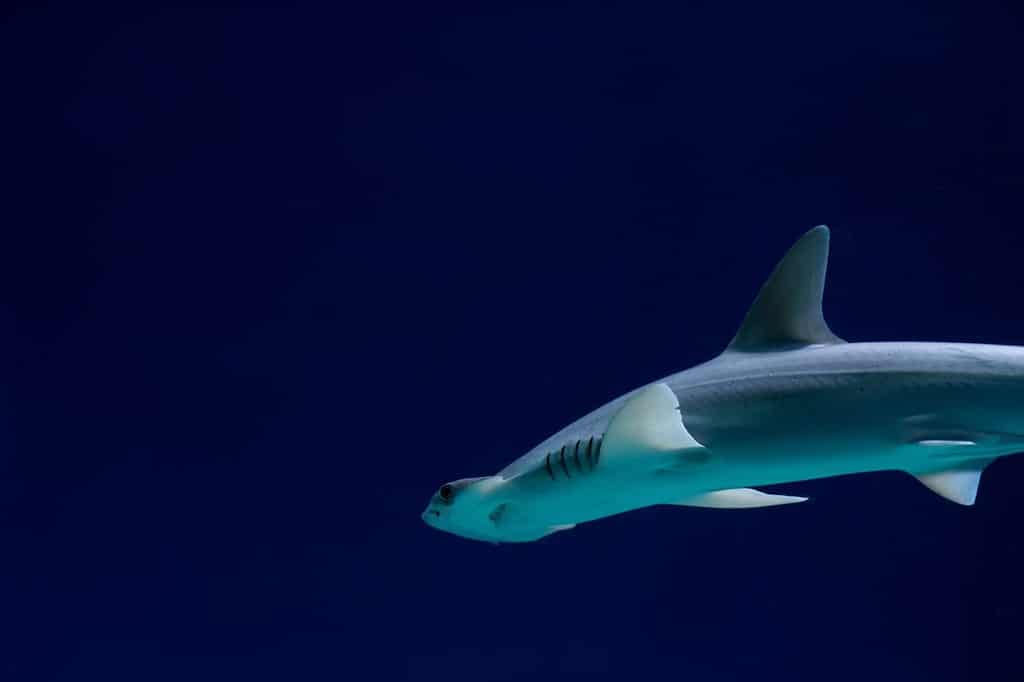
Gray smooth-hound sharks are slender sharks that live for up to 9 years.
©Elina Leon/Shutterstock.com
Great White Sharks
For years, experts believed that great white sharks rarely visited the coasts of California, but research has shown that more and more juvenile great whites travel near the shores of some California beaches. Still, an encounter with a great white shark in San Diego and La Jolla is rare, and most of the time swimmers and surfers have no clue.
Great white sharks, also called white sharks, are apex predators. They are highly migratory sharks that can grow up to 19 feet long, although they are more commonly 11 to 16 feet long. Females are larger than male great whites. Great white sharks can be found in shallow water or depths of 3,900 feet. Although great white sharks have a scary reputation, they are listed as Vulnerable on the IUCN Red list. In Europe, they are classified as Critically Endangered.
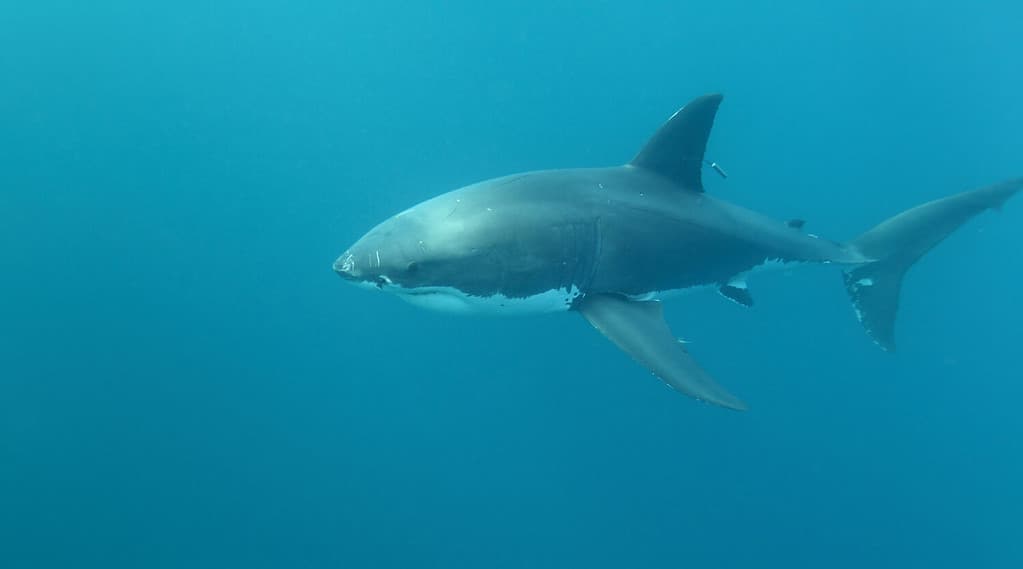
Great white sharks can be found throughout California, especially during summer.
©Alessandro De Maddalena/Shutterstock.com
Thresher Sharks
While you are more likely to spot a leopard shark in San Diego and La Jolla, thresher sharks are sometimes also spotted. Thresher sharks are most common off the coast of southern California, but there’s no guarantee you’ll see one.
Thresher sharks are easy to identify from their massive, unique-shaped tail. There are multiple species of thresher sharks found throughout the world. Typically, the thresher sharks you can see in California are pelagic threshers. They are more common in deeper waters far from the shore but may enter coastal habitats when hunting for food. Thresher sharks are listed as Endangered on the IUCN Red List. No human attacks have been recorded. Pelagic threshers, despite their massive tail, have small mouths and typically swim away from divers. Interestingly, pelagic thresher sharks are the smallest of the thresher sharks, although they reach up to 10 feet long.
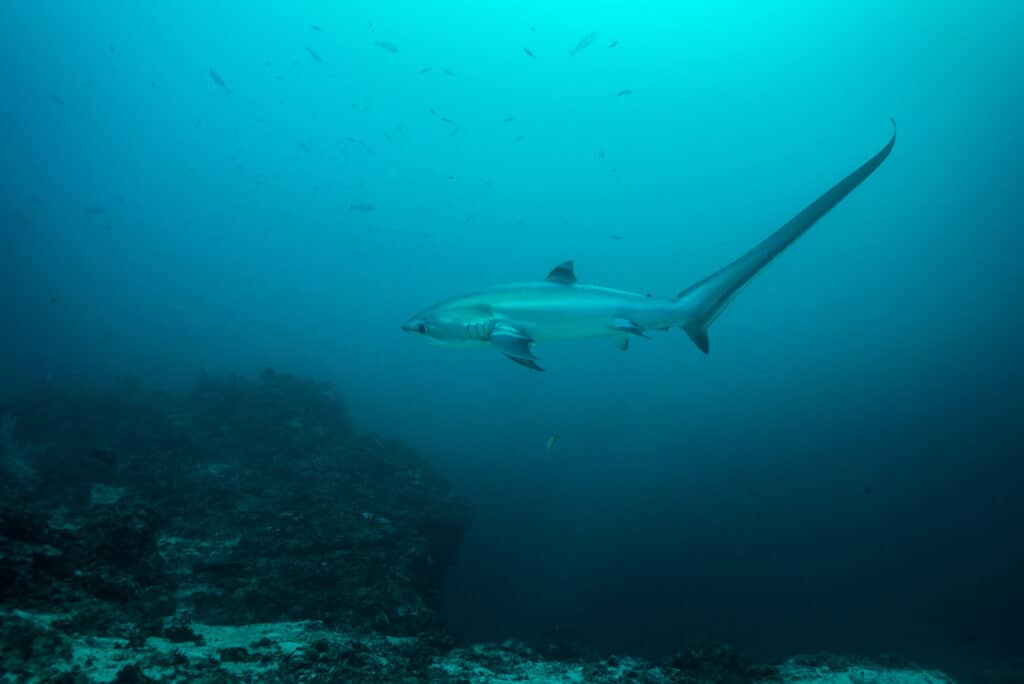
Thresher sharks have long tails. There are multiple species of thresher sharks found throughout the world.
©bearacreative/Shutterstock.com
Shortfin Mako Sharks
Mako sharks are also rarer to see compared to other shark species, but you may still see one. These sharks are best seen in southern California, including La Jolla. In over 12 years, researchers have tagged at least 105 shortfin mako sharks and tracked their movement. These highly migratory and fast sharks return to California every year, according to data. They remember and recognize the Southern California Bight, a strip of ocean from Santa Barbara south to San Diego.
Shortfin mako sharks are impressive predators. They are about 8 to 10 feet long but can reach as much as 13 feet long. They can also weigh as much as 1,260 pounds. Shortfin makos hunt by lunging quickly vertically and tearing into their prey. They mainly eat bony fish but also consume sea turtles and other sharks.

Shortfin mako sharks can grow up to 13 feet long.
©Xavier ELIAS Photography/Shutterstock.com
Blue Sharks
Next on our list is the blue shark, a requiem shark, in the family Carcharhinidae. They also live near San Diego and La Jolla, however, they are deep-water sharks, rarely venturing into coastal waters. Blue sharks are also sometimes called great blue sharks. They are highly migratory and are also very long and heavy. Blue sharks can reach about 12 feet long. While some people have reported observing a blue shark as long as 20 feet, these reports were never confirmed. Blue sharks don’t do well in captivity. They are pelagic fish and need space to swim. The longest a blue shark has ever lived in captivity was 873 days, but it died from disordered swimming due to dehydration.

Blue sharks are highly migratory fish. They are hard, if not impossible, to keep in captivity.
© Alessandro De Maddalena/ via Getty Images
Hammerhead Sharks
Last but not least is one of the most uncommon shark species in San Diego and La Jolla, the hammerhead. Although uncommon, these unique sharks have been recorded swimming in coastal areas and surrounding kayakers. Hammerhead sharks are a group of sharks, known for their hammer-like heads. They have a long range and vary in size. Adult hammerheads can grow to about 2 feet and 11 inches to 19 feet and 8 inches long. Hammerheads are excellent hunters, with great eyesight. Despite their size, no fatal hammerhead shark attacks have ever been recorded.
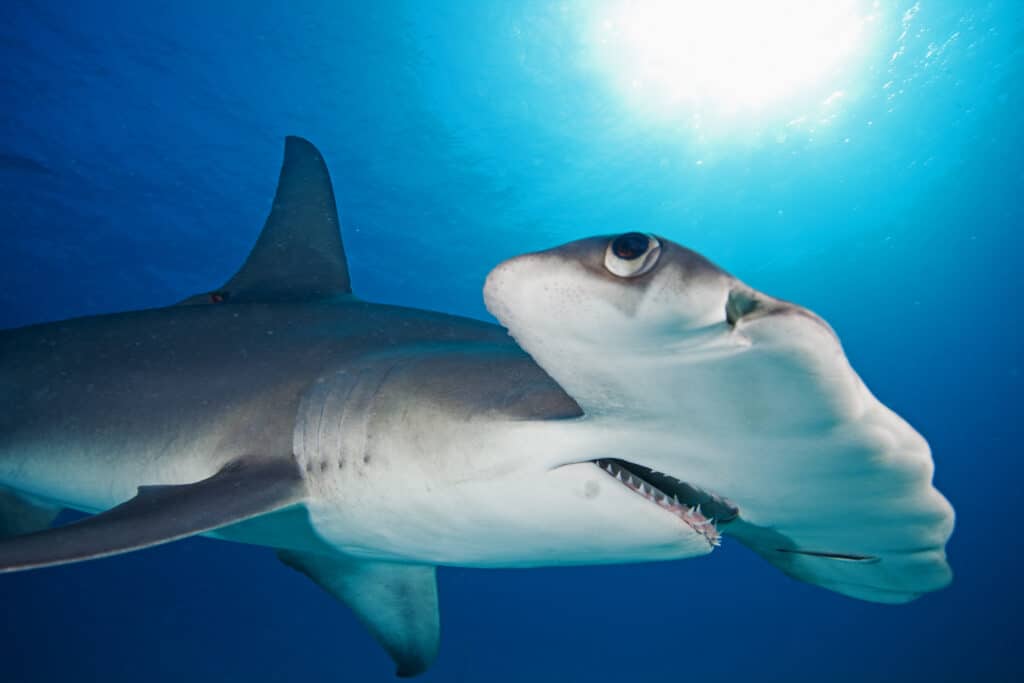
Hammerhead sharks aren’t the most common shark in California.
©Martin Prochazkacz/Shutterstock.com
The photo featured at the top of this post is © Barbara Ash/Shutterstock.com
Thank you for reading! Have some feedback for us? Contact the AZ Animals editorial team.






